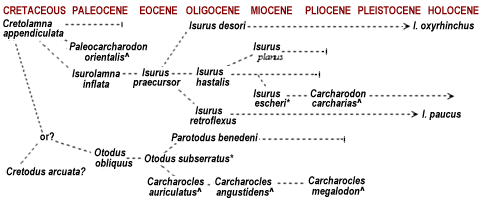| |

Subject: Paleocarcharadon megaladon
Date: Fri, 22 Nov 1996 01:49:46 -0800
From: Bill Heim
Reply-To: Sharks and Cartilaginous Fish Discussion
To: SHARK-L@RAVEN.UTC.EDU
I possess fossil teeth of all 3 white shark lineages and when you lay them out the
evidence is fairly obvious. Below is a timeline of species.
Note that Paleocarcharodon branches off early as does the lineage that leads to
Carcharocles megalodon. Carcharodon carcharias arises out of the mako line (which is
why they resemble each other so closely). Henri Cappetta places megalodon in a
seperate family, OTODONTIDAE vice LAMNIDAE, which I agree with. With a completely
different evolutionary history there is no way one can logically lump them into the
same genus. Also note that intermediate fossils exist such as irregularly serrated
(i.e. with weak, wavy serrations) Isurus teeth (I. escherei) and irregularly serrated
Otodus teeth (O. subserratus) as well as teeth with partial serrations, i.e. ones that
are serrated only part way up the blade.
 |
| Notes: |
| * |
partially or weakly serrate teeth |
| ^ |
completely serrate teeth (note: some Paleocarcharodon's are only
partially serrated and all of them have very irregular serrations) |
| ? |
Unable to determine if Otodus arose out of Cretolamna or
Cretodus as it shares features of both. More study is indicated. |
 |
| ILLUSTRATIONS |
Finally between the two genuses, Carcharodon and Carcharocles the teeth differ in
recognizable and consistant ways.
- Carcharodon
- Large, irregular serrations
- Small, narrow basal scar on lingual enamel
- Large, cloacal nutritive pores (pores where nerves and blood vessels enter tooth root are
large and grouped together)
- Thin, flattened blade on upper teeth
|
- Carcharocles
- Smaller, regular serrations
- Large chevron shaped basal scar on lingual enamel.
(chevron shaped scar where the enamel meets the root on
the curved side of the tooth)
- Smaller, scattered nutritive pores
- Thicker in cross section
|
|